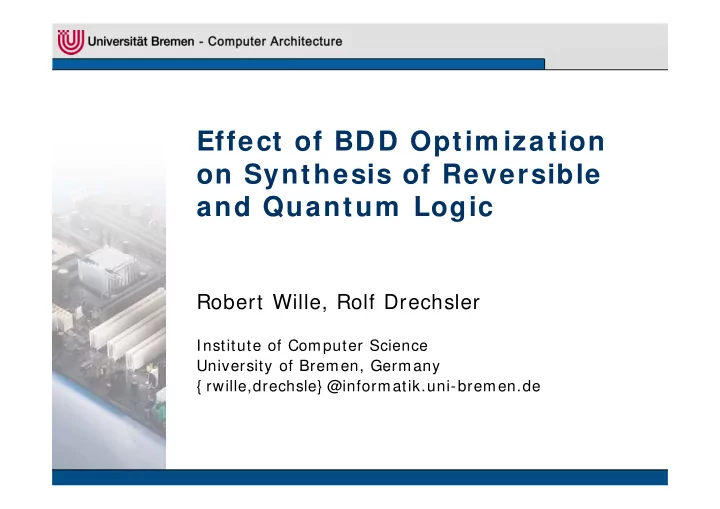

Effect of BDD Optim ization Effect of BDD Optim ization on Synthesis of Reversible and Quantum Logic d Q L i Robert Wille, Rolf Drechsler , Institute of Computer Science University of Bremen, Germany University of Bremen, Germany { rwille,drechsle} @informatik.uni-bremen.de
Outline • • Motivation and Background Motivation and Background • BDD-based Synthesis • Exploiting BDD-optimization – Shared Nodes – Complement Edges Complement Edges – Reordering • Experimental Results • Conclusions Conclusions 2
Reversible Logic • • Applications in Applications in – Quantum Computing – Low-Power Design Low Power Design – Optical Computing – DNA Computing DNA C ti – … 1 1 1 1 1 0 Toffoli gate Toffoli gate 3
Quantum Logic • Is inherently reversible • • Signals represented by qubits Signals represented by qubits (i.e. non-Boolean values) • • Value of each qubit is restricted to 0 1 V or V Value of each qubit is restricted to 0, 1, V 0 or, V 1 • NOT NOT: P f Peforms inversion i i 1 1 1 1 1 1 • CNOT: controled inversion • • V: V: ‘square root’ of NOT square root of NOT 1 1 0 0 V V 1 1 1 V V 0 0 0 V V V+ • V+ : inverse of V 4
Synthesis Problem • Gi Given: Rev. function to R f ti t • T Task: Find network k Fi d t k be synthesized (i.e. a cascade of gates) � No fanouts, no feedback • Previous Work: • Often rely on truth table (or similar) description � Only applicable to small functions 5
Outline • • Motivation and Background Motivation and Background • BDD-based Synthesis • Exploiting BDD-optimization – Shared Nodes – Complement Edges Complement Edges – Reordering • Experimental Results • Conclusions Conclusions 6
Binary Decision Diagram s ( BDDs) • Data structure for efficient representation and manipulation of Boolean functions • Rooted, directed, acyclic graph, which consists of g ap , o s s s o decision nodes and two terminal nodes (leafs) • Each decision node is labeled by a Boolean variable and has two child nodes (low and high) nodes (low and high) 7
BDD-based Synthesis # 1 1. Build BDD for function f using existing techniques 2. Substitute each BDD node by a cascade of gates 8
9 BDD-based Synthesis # 2
10 Exam ple ( XOR function)
BDD-based Synthesis # 3 • Linear worst case behavior regarding run-time g g and space requirements • Resulting circuits are bounded by BDD size � BDD optimization can be exploited 11
Outline • • Motivation and Background Motivation and Background • BDD-based Synthesis • Exploiting BDD-optimization – Shared Nodes – Complement Edges Complement Edges – Reordering • Experimental Results • Conclusions Conclusions 12
Shared Nodes • • Used to represent a sub formula more than once Used to represent a sub-formula more than once • Need to preserve node values (requires additional line) (requires additional line) 13
Com plem ent Edges • Allows to represent a function as well as its p negation by a single node only 14
15 Can be directly Reordering y adjustments) (no further (no further applied
Outline • • Motivation and Background Motivation and Background • BDD-based Synthesis • Exploiting BDD-optimization – Shared Nodes – Complement Edges Complement Edges – Reordering • Experimental Results • Conclusions Conclusions 16
Experim ental Setup • Implemented on the top of CUDD • • Benchmarks from RevLib (www revlib org) and Benchmarks from RevLib (www.revlib.org) and LGSynth package • Objectives: – Circuit lines Circuit lines – Number of Toffoli gates – Quantum Cost Quantum Cost – Run-time (often negligible) 17
18 Results ( selected)
Com parison to Previous W ork • RMRLS G RMRLS: Gupta et al. @ TCAD, 2006 t t l @ TCAD 2006 • RMS: Maslov et al. @ TODAES, 2007 • Significant run-time for both RMRLS and RMS • Most of the functions aborted after 500 CPU seconds 19
Outline • • Motivation and Background Motivation and Background • BDD-based Synthesis • Exploiting BDD-optimization – Shared Nodes – Complement Edges Complement Edges – Reordering • Experimental Results • Conclusions Conclusions 20
Conclusions • BDD-based synthesis has been introduced y • Effect of BDD optimization Effect of BDD optimization – Shared Nodes: Always yields better results – Compl. Edges: Better results in most cases Compl. Edges: Better results in most cases – Orderings: Best results with exact ordering, but Sifting also yields good circuits g y g • Comparison to Previous Work: Comparison to Previous Work: – Larger functions can be handled – Significant improvements in quantum cost Significant improvements in quantum cost – More circuit lines needed 21
Effect of BDD Optim ization Effect of BDD Optim ization on Synthesis of Reversible and Quantum Logic d Q L i Robert Wille, Rolf Drechsler , Institute of Computer Science University of Bremen, Germany University of Bremen, Germany { rwille,drechsle} @informatik.uni-bremen.de
Recommend
More recommend